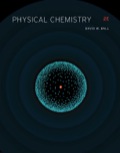
Concept explainers
Determine the number of total degrees of freedom and the number of vibrational degrees of freedom for the following molecules. (a) Hydrogen fluoride,
(a)
Interpretation:
For the molecule hydrogen fluoride,
Concept introduction:
To describe the positions of each of the atoms in a molecule having
Answer to Problem 14.45E
For the molecule Hydrogen fluoride,
Explanation of Solution
Hydrogen fluoride is a linear molecule. The total number of atoms present in hydrogen fluoride is
The total degrees of freedom is calculated by the formula given below.
Where,
•
The value of
Substitute the value of
Since,
Therefore, the number of total degrees of freedom is
For the molecule Hydrogen fluoride,
(b)
Interpretation:
For the molecule hydrogen telluride,
Concept introduction:
To describe the positions of each of the atoms in a molecule having
Answer to Problem 14.45E
For the molecule hydrogen telluride,
Explanation of Solution
Hydrogen telluride is a non-linear molecule. The total number of atoms present in hydrogen telluride is
The total degrees of freedom is calculated by the formula given below.
Where,
•
The value of
Substitute the value of
Since,
Therefore, the number of total degrees of freedom is
For the molecule hydrogen telluride,
(c)
Interpretation:
For the molecule Buckminsterfullerene,
Concept introduction:
To describe the positions of each of the atoms in a molecule having
Answer to Problem 14.45E
For the molecule Buckminsterfullerene,
Explanation of Solution
Buckminsterfullerene is a non-linear molecule. The total number of atoms present in Buckminsterfullerene is
The total degrees of freedom is calculated by the formula given below.
Where,
•
The value of
Substitute the value of
Since,
Therefore, the number of total degrees of freedom is
For the molecule Buckminsterfullerene,
(d)
Interpretation:
For the molecule phenylalanine,
Concept introduction:
To describe the positions of each of the atoms in a molecule having
Answer to Problem 14.45E
For the molecule Phenylalanine,
Explanation of Solution
Phenylalanine is a non-linear molecule. The total number of atoms present in phenylalanine is
The total degrees of freedom is calculated by the formula given below.
Where,
•
The value of
Substitute the value of
Since,
Therefore, the number of total degrees of freedom is
For the molecule phenylalanine,
(e)
Interpretation:
For the molecule naphthalene,
Concept introduction:
To describe the positions of each of the atoms in a molecule having
Answer to Problem 14.45E
For the molecule Naphthalene,
Explanation of Solution
Naphthalene is a non-linear molecule. The total number of atoms present in naphthalene is
The total degrees of freedom is calculated by the formula given below.
Where,
•
The value of
Substitute the value of
Since,
Therefore, the number of total degrees of freedom is
For the molecule Naphthalene,
(f)
Interpretation:
For the molecule linear isomer of the
Concept introduction:
To describe the positions of each of the atoms in a molecule having
Answer to Problem 14.45E
For the molecule the linear isomer of the
Explanation of Solution
For the linear isomer of the
The total degrees of freedom is calculated by the formula given below.
Where,
•
The value of
Substitute the value of
Since,
Therefore, the number of total degrees of freedom is
For the molecule the linear isomer of the
(g)
Interpretation:
For the molecule the bent isomer of
Concept introduction:
To describe the positions of each of the atoms in a molecule having
Answer to Problem 14.45E
For the molecule the bent isomer of
Explanation of Solution
For the bent isomer of the
The total degrees of freedom is calculated by the formula given below.
Where,
•
The value of
Substitute the value of
Since,
Therefore, the number of total degrees of freedom is
For the molecule the bent isomer of
Want to see more full solutions like this?
Chapter 14 Solutions
EBK PHYSICAL CHEMISTRY
- What is the formula of the compound 3-isopropylcyclopentane-1-carbonyl chloride?arrow_forwardIndicate the products of the reaction between CH3COCH2COONa (Sodium acetoacetate) and BrCH2COOC2H5arrow_forwardIndicate whether the product of the reaction between Naphthalene and CrO3 in acetic acid at 25ºC is 1,4 naphthoquinone or phthalic anhydride.arrow_forward
- Indicate the products of the reaction between CH3COCH2COOC2H5 and Na+-OC2H5.arrow_forwardPrimary, Secondary, and Tertiary Alcohols O-H O-H O-H R₁-C-H R₁-C-H R₁-C-R₁ H R₂ R₂ Primary Alcohol Secondary Alcohol ChemistryLearner.com R stands for Carbon group like ethyl methyl propyl Tertiary Alcohol If 1 carbon group with two H attached to alcoholic carbon, then primary If 2 carbon group and 1 H are attached to alcoholic carbon, then secondary IF 3 carbon group and no H attach to alcoholic carbon then tertiary. The bottom line Starting "Weak" oxidant material PCC, DMP, Swern, etc Primary alcohol Aldehyde OH Secondary alcohol Ketone OH "Strong" oxidant KMnO4, H₂CrO4 (or equivalent) OH Carboxylic acid 요 Ketone No reaction No reaction Tertiary alcohol 1. Is ethanol a primary, secondary, or tertiary alcohol? Write out the structures of ethanol and any oxidation products of ethanol. If there is more than one oxidation product, give the structure of each of the products. 2. Is 2-propanol a primary, secondary, or tertiary alcohol? Write out the structures of 2-propanol and any…arrow_forwardFormulate the reaction: Naphthalene with CrO3 in acetic acid at 25ºCarrow_forward
- Complete the following equations please hand written pleasearrow_forwardUsing the Nernst equation to calculate nonstandard cell voltage A galvanic cell at a temperature of 25.0 °C is powered by the following redox reaction: 3+ 3Cu²+ (aq) +2Al(s) → 3 Cu(s)+2A1³* (aq) 2+ Suppose the cell is prepared with 5.29 M Cu in one half-cell and 2.49 M A1³+ in the other. Calculate the cell voltage under these conditions. Round your answer to 3 significant digits. x10 μ ☑ 00. 18 Ar Иarrow_forwardPlease help me solve this homework problemarrow_forward
 Physical ChemistryChemistryISBN:9781133958437Author:Ball, David W. (david Warren), BAER, TomasPublisher:Wadsworth Cengage Learning,
Physical ChemistryChemistryISBN:9781133958437Author:Ball, David W. (david Warren), BAER, TomasPublisher:Wadsworth Cengage Learning, Principles of Modern ChemistryChemistryISBN:9781305079113Author:David W. Oxtoby, H. Pat Gillis, Laurie J. ButlerPublisher:Cengage Learning
Principles of Modern ChemistryChemistryISBN:9781305079113Author:David W. Oxtoby, H. Pat Gillis, Laurie J. ButlerPublisher:Cengage Learning

